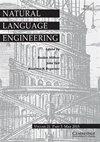Neural Arabic singular-to-plural conversion using a pretrained Character-BERT and a fused transformer
IF 1.9
3区 计算机科学
Q3 COMPUTER SCIENCE, ARTIFICIAL INTELLIGENCE
引用次数: 0
Abstract
Abstract Morphological re-inflection generation is one of the most challenging tasks in the natural language processing (NLP) domain, especially with morphologically rich, low-resource languages like Arabic. In this research, we investigate the ability of transformer-based models in the singular-to-plural Arabic noun conversion task. We start with pretraining a Character-BERT model on a masked language modeling task using 1,134,950 Arabic words and then adopting the fusion technique to transfer the knowledge gained by the pretrained model to a full encoder–decoder transformer model, in one of the proposed settings. The second proposed setting directly fuses the output Character-BERT embeddings into the decoder. We then analyze and compare the performance of the two architectures and provide an interpretability section in which we track the features of attention with respect to the model. We perform the interpretation on both the macro and micro levels, providing some individual examples. Moreover, we provide a thorough error analysis showing the strengths and weaknesses of the proposed framework. To the best of our knowledge, this is the first effort in the Arabic NLP domain that adopts the development of an end-to-end fused-transformer deep learning model to address the problem of singular-to-plural conversion.使用预训练Character-BERT和熔断变压器的神经阿拉伯语单数到复数转换
形态重屈折的生成是自然语言处理(NLP)领域中最具挑战性的任务之一,特别是对于像阿拉伯语这样形态丰富、资源匮乏的语言。在本研究中,我们研究了基于变压器的模型在阿拉伯名词单复数转换任务中的能力。我们首先在使用1,134,950个阿拉伯单词的掩码语言建模任务上预训练Character-BERT模型,然后采用融合技术将预训练模型获得的知识转移到一个完整的编码器-解码器转换器模型中,在其中一个建议的设置中。第二种建议直接将输出的Character-BERT嵌入融合到解码器中。然后,我们分析和比较了两种架构的性能,并提供了一个可解释性部分,在该部分中,我们跟踪了与模型相关的注意力特征。我们从宏观和微观两个层面进行解释,并提供了一些单独的例子。此外,我们提供了一个彻底的错误分析,显示了所提议的框架的优点和缺点。据我们所知,这是阿拉伯语NLP领域首次采用端到端融合变压器深度学习模型来解决单数到复数转换问题。
本文章由计算机程序翻译,如有差异,请以英文原文为准。
求助全文
约1分钟内获得全文
求助全文
来源期刊

Natural Language Engineering
COMPUTER SCIENCE, ARTIFICIAL INTELLIGENCE-
CiteScore
5.90
自引率
12.00%
发文量
60
审稿时长
>12 weeks
期刊介绍:
Natural Language Engineering meets the needs of professionals and researchers working in all areas of computerised language processing, whether from the perspective of theoretical or descriptive linguistics, lexicology, computer science or engineering. Its aim is to bridge the gap between traditional computational linguistics research and the implementation of practical applications with potential real-world use. As well as publishing research articles on a broad range of topics - from text analysis, machine translation, information retrieval and speech analysis and generation to integrated systems and multi modal interfaces - it also publishes special issues on specific areas and technologies within these topics, an industry watch column and book reviews.
 求助内容:
求助内容: 应助结果提醒方式:
应助结果提醒方式:


